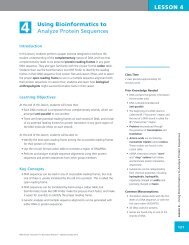WET LAB DNA Barcoding: From Samples to Sequences - Northwest ...
WET LAB DNA Barcoding: From Samples to Sequences - Northwest ...
WET LAB DNA Barcoding: From Samples to Sequences - Northwest ...
Create successful ePaper yourself
Turn your PDF publications into a flip-book with our unique Google optimized e-Paper software.
<strong>WET</strong> <strong>LAB</strong><br />
CLASS SET<br />
Lab 3: Analyzing PCR Results<br />
with Agarose Gel Electrophoresis<br />
Student Researcher Background:<br />
What is Agarose Gel Electrophoresis?<br />
Agarose gel electrophoresis is a procedure used <strong>to</strong> determine the presence and size of pieces of <strong>DNA</strong>. By<br />
analyzing the results of PCR on an agarose gel, genetic researchers are able <strong>to</strong> determine: (1) whether the PCR<br />
reaction was successful, indicated by the presence of a <strong>DNA</strong> band on the gel; and (2) whether the PCR reaction<br />
resulted in a PCR of the expected size or molecular weight.<br />
Agarose is a powdered material made from seaweed. After mixing the agarose powder in buffer and heating it<br />
<strong>to</strong> melting in the microwave, the liquid is poured in<strong>to</strong> a small mold (similar <strong>to</strong> the procedure used when making<br />
Jell-O ® ). A comb is placed in the liquid <strong>to</strong> make small holes or wells in which <strong>to</strong> put the <strong>DNA</strong>. After placing the gel<br />
in the gel box (see Figure 3.1), <strong>DNA</strong> samples are mixed with loading dye and a single <strong>DNA</strong> sample is loaded in<strong>to</strong><br />
each well of the gel. Loading dye is often concentrated, such as 3X or 6X, and is diluted with water and/or your<br />
<strong>DNA</strong> sample. An electric current is then passed through the gel; since <strong>DNA</strong> is negatively charged, it flows through<br />
the gel <strong>to</strong> the positive electrode (anode). The rate at which the <strong>DNA</strong> moves through the gel is determined by its<br />
size or molecular weight—smaller molecules travel more quickly, and larger molecules travel more slowly.<br />
Figure 3.1: Running a <strong>DNA</strong> Gel.<br />
How Do You Know the Molecular Weight of Your <strong>DNA</strong> <strong>Samples</strong>?<br />
By including a known molecular weight standard on your gel, you<br />
can determine the size of your <strong>DNA</strong> bands or PCR products. Molecular<br />
weight standards, often abbreviated “MW,” contain pieces of <strong>DNA</strong><br />
of known sizes. By comparing your <strong>DNA</strong> band <strong>to</strong> the band(s) of the<br />
molecular weight standard, you can estimate the size and concentration<br />
of your <strong>DNA</strong> band(s). You can also make a graph of the molecular<br />
weight standards relative <strong>to</strong> the distance each molecular weight<br />
standard band traveled through the gel. This allows for a more accurate<br />
estimation of the size of your <strong>DNA</strong> band(s).<br />
Agarose gels are stained <strong>to</strong> visualize the <strong>DNA</strong> bands they contain—both the<br />
molecular weight standards and your PCR products. Some stains, such as<br />
ethidium bromide, can be very <strong>to</strong>xic. Other stains such as Fast Blast made<br />
by Bio-Rad Labora<strong>to</strong>ries are much safer for student researchers <strong>to</strong> use.<br />
Molecular weight standard:<br />
Sometimes called a “molecular<br />
weight marker” or “<strong>DNA</strong> ladder”<br />
and abbreviated “MW,” this is a<br />
mixture of <strong>DNA</strong> fragments of known<br />
size used <strong>to</strong> identify the approximate<br />
size of a molecule run on a gel,<br />
using the principle that molecular<br />
weight is inversely proportional<br />
<strong>to</strong> migration rate through a gel<br />
matrix. Therefore, when used in gel<br />
electrophoresis, standards effectively<br />
provide a logarithmic scale by which<br />
<strong>to</strong> estimate the size of the other<br />
fragments (providing the fragment<br />
sizes of the standard are known).<br />
Standards are loaded in lanes<br />
adjacent <strong>to</strong> sample lanes before the<br />
run commences.<br />
PCR product: The <strong>DNA</strong> copied or<br />
“amplified” during PCR.<br />
Wet Lab – <strong>DNA</strong> <strong>Barcoding</strong>: <strong>From</strong> <strong>Samples</strong> <strong>to</strong> <strong>Sequences</strong><br />
359<br />
©<strong>Northwest</strong> Association for Biomedical Research—Updated Oc<strong>to</strong>ber 2012
















